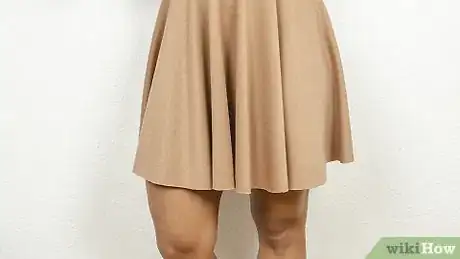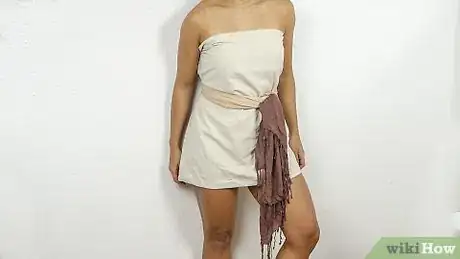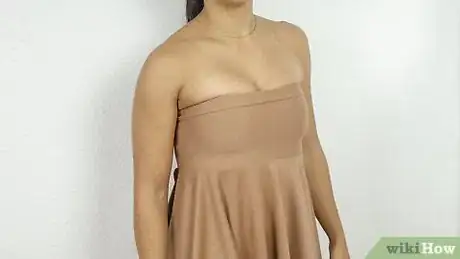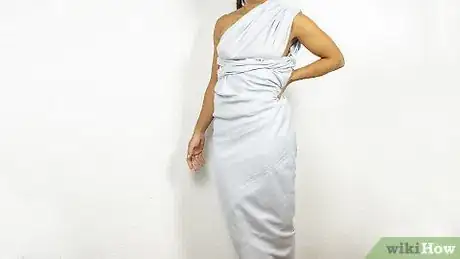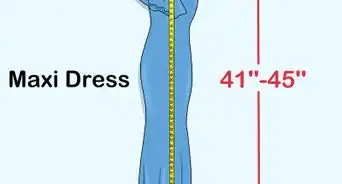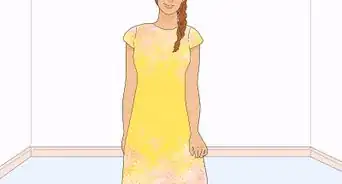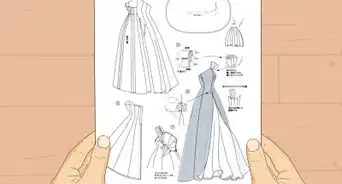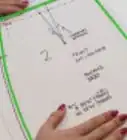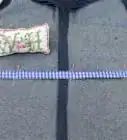This article was co-authored by Kpoene Kofi-Bruce. Kpoene Kofi-Bruce is a tailor, couture wedding gown designer, and the Creative Director of Mignonette Bridal and Ette the Wedding Tailor in Chicago, Illinois. With nearly two decades of experience as a wedding gown designer, small business owner, and vintage sewing enthusiast, Kpoene specializes in wedding gown design and the social history of wedding dresses. She received a BA in Creative Writing from Middlebury College and studied the business of fashion at the Fashion Institute of Technology. She is also a graduate of the Goldman Sachs 10KSB program and the Chicago Fashion Incubator and has written about wedding fashion for Jezebel, Catalyst, the Sun Times, and XO Jane.
This article has been viewed 243,292 times.
There are lots of kinds of dresses that you can make but if you're a beginner and you want to make something very versatile, an infinity dress is a good place to start. This dress requires only one seam and can convert into lots of different styles. This makes it easy to dress it up for a wedding or dress it down for a night out with your friends. This pattern is easily adjusted to make a dress in any size and at any length.
Steps
Buying and Cutting Your Material
-
1Buy a stretchy, knit material. You will want a material for your dress that is stretchy. This is absolutely necessary for an infinity dress. Although you can get lots of materials that are stretchy, knits which contain spandex are generally the easiest to use and will look the best if you're sewing as a beginner.
- You can technically buy any fabric that you want for the skirt itself but the stretchy material will be absolutely necessary for the straps and waistband.
- Always buy a few more yards of fabric than you will need, so that you can test your needles, feet, thread, etc., and also so that you can recut anything you mess up. [1]
-
2Cut the material for the skirt.[2] Measure around the smallest part of your waist and then subtract 3". This will be the measurement for the waist of your dress. The skirt is a circle skirt, so you will need to cut it from a bolt that is at least as wide as your waist is across and then double the length that you want your skirt. This is very doable if making one big circle for a cocktail length dress. However, if you want yours to be longer, you will need to break the circle down into quarters.
- Make a circle at the center of your fabric at the size you measured for your waist. Using that same center point, draw the larger circle for the skirt itself. This should leave you with a small circle inside of a big circle. Cut out the center circle so that your waist has somewhere to go.
- The space between the waist and the edge of the larger circle is the length that the skirt will be.
- You might want to try this on large sheets of paper before doing it on fabric.
- If you break the skirt down into quarters, don't forget to leave a seam allowance between the quarters when you cut them, at least at the waist.
Advertisement -
3Cut the material for the waistband. Take the same waist measurement that you used for the skirt and use that to make the waist band. It will need to be cut to that length and then about 14-20" high.
- When it's cut out, you'll want to fold it over so that the wrong sides are touching each other. This should leave you with a strip of doubled up fabric roughly (your waist measurement) x 10" (or less).
-
4Cut the material for the straps. Take your height and multiply it by 1.5. This is how long the straps will need to be. The width depends on how big of a chest you have (flat chest gets 10", average 12", large 14"). Get a single run of fabric that is at least this long. It will work much better if the straps are cut lengthwise than width-wise, since it will reduce rolling.
- Since this will be long and continuous, you will be left with a lot of fabric. However, if the bolt you bought was wide enough, you should have enough material left over for two more straps, which you can use to make another dress.
- Be warned, cutting the straps is not easy. That length of fabric can be a challenge. Try folding the fabric back and forth, like you were folding a zig zag with paper. Place the pile so that you can pull from the top going towards you and then weight down the extra. Only work with a length you are comfortable with and measure and cut that one section at a time, pulling out more fabric as you need it.
Sewing the Dress
-
1Arrange and pin the straps to the skirt. Line up the straps so that one end of each of them matches up with the edge of the waist. The facing sides of the fabric on the skirt and straps should be touching. Now, here's where things get tricky. You're going to overlap the straps just a bit and angle them like a V, so that they overlap in a little triangle shape (the base of the triangle overlap being at the waist and point down to the hem of the skirt). Pin these pieces together once you've gotten them arranged.
- The amount that the overlap should be depends on your body and how it is shaped. Generally, the triangle of overlap should be about 5-7" long from base to point.
- This overlap is what keeps your chest covered. You can have them not overlap but you'll be making a deep-plunge dress and might need to wear something underneath it.[3]
-
2Arrange and pin the waistband. Now, with your waistband folded over, begin pinning the raw edges to the waist so that the right sides are facing. It's a good idea to put the center of the waistband opposite from the center of the strap overlap. This way the seam of the joined ends of the waistband will be hidden. Once you've lined up all the edges, pin it in place.
-
3Sew the waist. There is one required seam in this dress and this is it. You are going to sew one continuous circle all around the waist. This will join together all three parts of the dress. Easy, right? Start anywhere on the waist circle that works for you, although somewhere around the side should be easiest to hide. Run the machine forward, back a little, and then forward and back again. This is called locking your stitches in place. Now keep going forward all around the circle until you reach the spot where you started. Back stitch again to finish it off.
-
4Hem the skirt.[4] If you want to, you can hem the skirt to get a more professional, clean edge. You don't have to, however, and certain fabrics should create a finished edge all on their own. Jersey is a good example of this.
Making Other Dresses
-
1Make a dress from a pillowcase. By adding an elastic top to a pillowcase, you can make a quick and easy tube dress. All you need to finish the look is a belt or other waist accessory. This is useful for Halloween costumes or as a way to practice your sewing skills (or just make good use of an old pillowcase).[5]
-
2Make an empire waist dress. An empire waist dress is a dress which is fitted just under the bust.[6] You can make an easy one by adding a skirt you make to a top you already own or buy. This is easy and looks very feminine and lady-like.
-
3Make a dress using a bedsheet. You can use a cute old bedsheet to make a nice dress. This requires only beginner sewing skills. It's a great project if you want to make a quirky dress using your childhood bedsheets (covered in your favorite cartoon character).
-
4Make a quick dress using your favorite skirt. You can make a really simple dress by attaching a top to your favorite skirt. This is a quick sewing project that is great for a beginner. Simply turn your shirt inside out and line up the waist bands (the skirt will be nested inside the shirt).
- Keep in mind that it has to be a stretch skirt with no zipper, since you won't be able to use the zipper anymore.
Expert Q&A
-
QuestionHow do you sew a zipper in a dress?
 Kpoene Kofi-BruceKpoene Kofi-Bruce is a tailor, couture wedding gown designer, and the Creative Director of Mignonette Bridal and Ette the Wedding Tailor in Chicago, Illinois. With nearly two decades of experience as a wedding gown designer, small business owner, and vintage sewing enthusiast, Kpoene specializes in wedding gown design and the social history of wedding dresses. She received a BA in Creative Writing from Middlebury College and studied the business of fashion at the Fashion Institute of Technology. She is also a graduate of the Goldman Sachs 10KSB program and the Chicago Fashion Incubator and has written about wedding fashion for Jezebel, Catalyst, the Sun Times, and XO Jane.
Kpoene Kofi-BruceKpoene Kofi-Bruce is a tailor, couture wedding gown designer, and the Creative Director of Mignonette Bridal and Ette the Wedding Tailor in Chicago, Illinois. With nearly two decades of experience as a wedding gown designer, small business owner, and vintage sewing enthusiast, Kpoene specializes in wedding gown design and the social history of wedding dresses. She received a BA in Creative Writing from Middlebury College and studied the business of fashion at the Fashion Institute of Technology. She is also a graduate of the Goldman Sachs 10KSB program and the Chicago Fashion Incubator and has written about wedding fashion for Jezebel, Catalyst, the Sun Times, and XO Jane.
Couture Bridal Designer Practice! I love zippers and they are also very intimidating. You can install a regular zipper with a normal foot, but if you want to master invisible zippers (and also learn to sew on lace, sew over beading, and do other magic sewing tricks), get acquainted with your zipper foot will change your sewing life. I recommend Youtube for good videos you can sew along too, especially for trickier types of closures like hidden zippers.
Practice! I love zippers and they are also very intimidating. You can install a regular zipper with a normal foot, but if you want to master invisible zippers (and also learn to sew on lace, sew over beading, and do other magic sewing tricks), get acquainted with your zipper foot will change your sewing life. I recommend Youtube for good videos you can sew along too, especially for trickier types of closures like hidden zippers. -
QuestionHow do you measure your bust size?
 Kpoene Kofi-BruceKpoene Kofi-Bruce is a tailor, couture wedding gown designer, and the Creative Director of Mignonette Bridal and Ette the Wedding Tailor in Chicago, Illinois. With nearly two decades of experience as a wedding gown designer, small business owner, and vintage sewing enthusiast, Kpoene specializes in wedding gown design and the social history of wedding dresses. She received a BA in Creative Writing from Middlebury College and studied the business of fashion at the Fashion Institute of Technology. She is also a graduate of the Goldman Sachs 10KSB program and the Chicago Fashion Incubator and has written about wedding fashion for Jezebel, Catalyst, the Sun Times, and XO Jane.
Kpoene Kofi-BruceKpoene Kofi-Bruce is a tailor, couture wedding gown designer, and the Creative Director of Mignonette Bridal and Ette the Wedding Tailor in Chicago, Illinois. With nearly two decades of experience as a wedding gown designer, small business owner, and vintage sewing enthusiast, Kpoene specializes in wedding gown design and the social history of wedding dresses. She received a BA in Creative Writing from Middlebury College and studied the business of fashion at the Fashion Institute of Technology. She is also a graduate of the Goldman Sachs 10KSB program and the Chicago Fashion Incubator and has written about wedding fashion for Jezebel, Catalyst, the Sun Times, and XO Jane.
Couture Bridal Designer Wear a bra that is unpadded and measure above your bust (the tape will be in your armpits), at the fullest part of your bust, and then below your bust. Most commercial patterns will give you more ease around the bust and waist than you will probably want, so just be aware of that as you choose your pattern.
Wear a bra that is unpadded and measure above your bust (the tape will be in your armpits), at the fullest part of your bust, and then below your bust. Most commercial patterns will give you more ease around the bust and waist than you will probably want, so just be aware of that as you choose your pattern. -
QuestionIs this suitable to make if I am a child?
 Community AnswerYes. Make sure you have parental permission first. Ask your mom or dad to go shop for fabric, and make sure you have supervision while using a machine. A sewing machine can be very dangerous if used incorrectly.
Community AnswerYes. Make sure you have parental permission first. Ask your mom or dad to go shop for fabric, and make sure you have supervision while using a machine. A sewing machine can be very dangerous if used incorrectly.
Things You'll Need
- sewing machine
- Fabric you like
- Large piece of paper
- Thread
- Needle( see warnings for details)
References
- ↑ Kpoene Kofi-Bruce. Couture Bridal Designer. Expert Interview. 28 January 2021.
- ↑ Kpoene Kofi-Bruce. Couture Bridal Designer. Expert Interview. 28 January 2021.
- ↑ http://knucklesalad.com/convertible-infinity-dress-how-it-almost-defeated-me-and-what-you-need-to-make-one/
- ↑ Kpoene Kofi-Bruce. Couture Bridal Designer. Expert Interview. 28 January 2021.
- ↑ https://bumblebeelinens.com/pillowcaseDress.php
- ↑ https://www.liveabout.com/the-empire-waist-dress-4114200
About This Article
To sew a dress, start by measuring and cutting the material for the skirt, waistband, and straps. Once all of your material is ready to be sewn together, arrange and pin the straps to the skirt. Then, pin the raw edges to the waist so that the right sides are facing up. After everything is pinned, start sewing the waist, on one side of the dress and then sew a continuous circle until you get back to where you began. Run the machine forward, back a little, and then forward and back again until the seam is complete. To learn how to buy and cut your material, scroll down.


